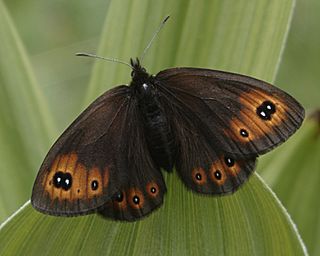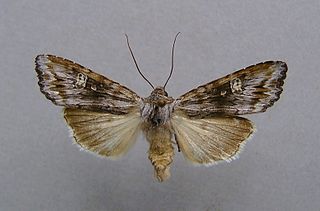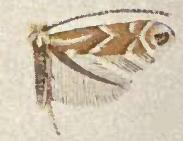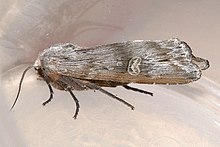
The Lasiocampidae are a family of moths also known as eggars, tent caterpillars, snout moths, or lappet moths. Over 2,000 species occur worldwide, and probably not all have been named or studied. It is the sole family in superfamily Lasiocampoidea.

Hemaris tityus, the narrow-bordered bee hawk-moth, is a moth of the family Sphingidae which is native to the Palearctic.

Lithomoia is a genus of moths of the family Noctuidae.

Autographa sansoni, the Alberta beauty, is a moth of the family Noctuidae. The species was first described by F. H. Wolley Dod in 1910. It is found in the western mountains of North America, from Alaska south to Oregon, Idaho and Arizona. Occurring mainly in the Pacific Northwest, it thrives in mid-to-high elevation conifer forest habitat, as well as some areas of coastal rain forest in the Coast range. However, it is also found in a non-contiguous range in sub-alpine forest in the Rocky Mountains, ranging from Alberta in the north, to New Mexico in the south. The wingspan of an adult ranges between 34 and 36 mm. It is widespread, and a relatively common species.

Apamea rubrirena is a moth of the family Noctuidae.

Lasionycta perplexa is a moth of the family Noctuidae. It is widely distributed from southern Alaska and Yukon in the north to California, Utah, and Colorado in the South. A disjunct population is found on the east coast of Hudson Bay at Kuujjuaraapik.

Erebia epipsodea, the common alpine, is a butterfly species of the subfamily Satyrinae of family Nymphalidae. It is found in North America from Alaska south through the Rocky Mountains to northern New Mexico and east across the prairie provinces to southwest Manitoba.

Euxoa ochrogaster, the red-backed cutworm, is a moth of the family Noctuidae. It is found from Iceland and northern Europe, through the Baltic to the Amur region. In North America, it is found from Alaska to Newfoundland and Labrador, south into the northern part of the United States, south in Rocky Mountains to Arizona and New Mexico.

Lithomoia solidaginis, the golden-rod brindle, is a moth of the family Noctuidae. The species was first described by Jacob Hübner in 1803. It is found in most of Europe, except the Iberian Peninsula, Ireland, Iceland and the western and southern part of the Balkan Peninsula. Then eastwards to the Urals, Kamchatka and Japan.In the Alps it rises to about 1500 meters. It is found mainly on marshy ground, in humid mixed forests as well as in tundra - and taiga areas.
Phyllonorycter erugatus is a moth of the family Gracillariidae. It is known in the United States from widely scattered localities from Santa Clara County near sea level in mid-coastal California north to southern Alaska and west to the Rocky Mountains of Colorado to elevations of 2,800 meters.

Phyllonorycter scudderella is a moth of the family Gracillariidae. It is widespread in eastern North America from Ontario to Ohio and in western North America from south-eastern Alaska to Oregon.

Phyllonorycter apicinigrella is a moth of the family Gracillariidae. It is found along the western coast of the United States from San Luis Obispo County, California, north to British Columbia, Canada.
Cameraria macrocarpae is a moth of the family Gracillariidae. It is only known from Manitoba, Canada.

Eupithecia pygmaeata, the marsh pug, is a moth of the family Geometridae. It is known from most of Europe, western and southern Siberia, the Russian Far East, northern Mongolia and North America .The species primarily colonizes floodplain and disused forests, bogs, river banks and marshy meadows. E. pygmaeata reaches up to 1800 meters in South Tyrol.

Macaria loricaria, the false Bruce spanworm or Eversmann's peacock, is a moth of the family Geometridae. It is found from Fennoscandia and the Baltic states to Sakhalin. It is also found in North America, where it is found from Alaska to Newfoundland and New York, south to Colorado.

Amblyptilia pica, the geranium plume moth, is a moth of the family Pterophoridae. The species was first described by Baron Walsingham in 1880. It is found in western North America from Alaska to California, inland to Alberta and Kansas. It is also found in the north-eastern United States and Ontario.

Callophrys augustinus, the brown elfin, is a species of butterfly of the family Lycaenidae, found from Alaska to northern Mexico. One of its subspecies, C. augustinus iroides, is known as the western elfin.

Eupithecia nimbicolor is a moth in the family Geometridae first described by George Duryea Hulst in 1896. It is found in North America from eastern Newfoundland and Labrador to western British Columbia and from Alaska to Arizona.

Chionodes viduella is a moth of the family Gelechiidae. It is found in France, Germany, Austria, Switzerland, Italy, the Czech Republic, Slovenia, Poland, Bulgaria, Norway, Sweden, Finland, the Baltic region and Russia. It is also found in northern North America, from Alaska to Maine.

Eana argentana is a moth of the family Tortricidae. It is found in Great Britain, Spain, France, Luxembourg, Belgium, the Netherlands, Germany, Austria, Switzerland, Italy, the Czech Republic, Slovakia, Poland, Albania, Bosnia and Herzegovina, Slovenia, Hungary, Bulgaria, Romania, North Macedonia, Greece, Norway, Sweden, Finland, the Baltic region and Russia. It is also present in western North America, where it has been recorded from Alaska, Alberta, Arizona, British Columbia, California, Maine, Montana, New Mexico, Washington and Wyoming. The habitat consists of high-elevation open habitats.















